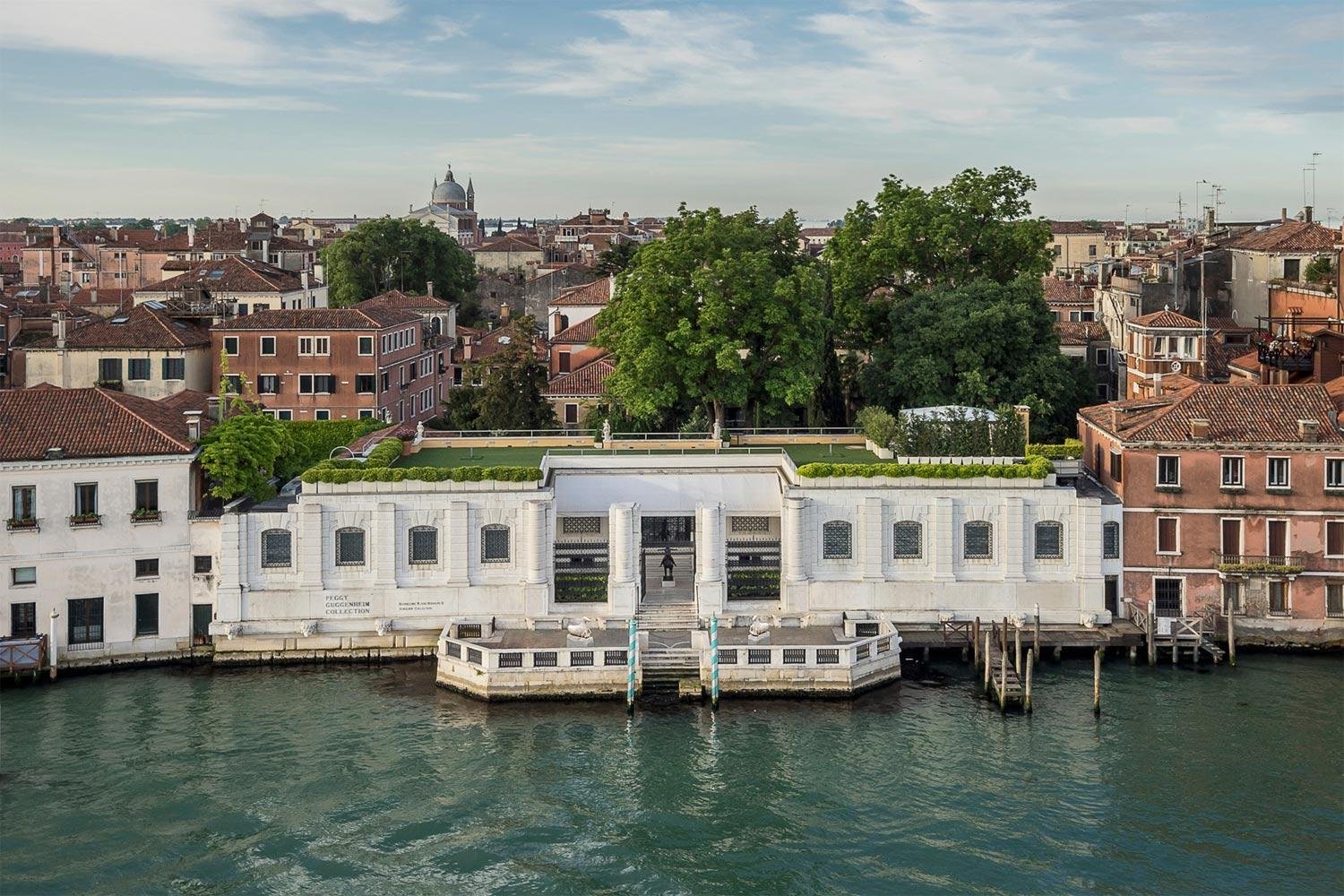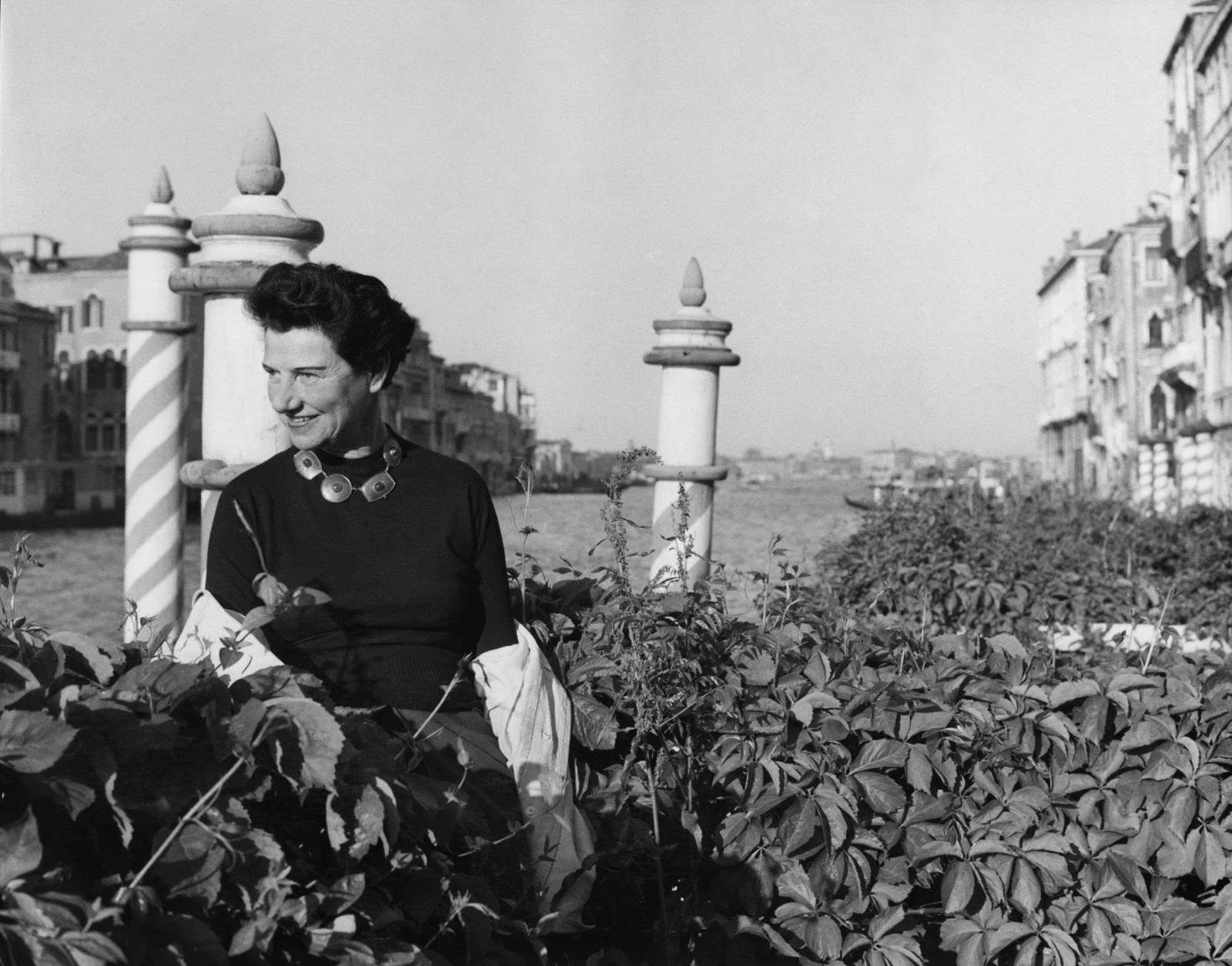The Guggenheim Collection: A Selection of Dada Artists @ The Peggy Guggenheim Collection, Venice
The Peggy Guggenheim Collection museum is one of the most significant institutions dedicated to twentieth century European and American art. Located in Venice, Italy, the collection is displayed across the outside sculpture garden through to the terrace and inside the Palazzo Venier dei Leoni, also the former residence of the acclaimed collector herself, Peggy Guggenheim. The collection presents a vast assortment of international movements and artists, amongst which Marcel Duchamp, Max Ernst, Man Ray, Francis Picabia and Kurt Schwitters, constructing the Dada Movement.
The Peggy Guggenheim Collection. Outside View from the Grand Canal. Photo Courtesy: The Peggy Guggenheim Collection.
Presenting an ensemble of art, unlike any other internationally, the Peggy Guggenheim Collection is regarded as a dictator of artistic taste and excellence amongst the art world. The collection contains specific pieces form each artist’s prime time of production. Most of the works are key examples of the beginning, end or characteristic style of the artist and relevant artistic movement.
The Peggy Guggenheim Collection. Installation View. Photo Courtesy: The Peggy Guggenheim Collection.
Located internationally, the extended Guggenheim family Collection has spaces in Venice, New York, Bilbao and forthcoming in Abu Dhabi. The doors to the Venice Palazzo opened in 1980 to the public and has become an increased attraction for the artworld today. Peggy Guggenheim’s incredible personal collection of twentieth century works of art came vigorously to life with the assistance of artists and critics of her times. Acquiring the majority of her collection in London, Paris and New York between 1938 and 1947, the renowned art patron decided to permanently reside in Palazzo Venier dei Leoni on Venice's Grand Canal where the collection is now displayed. With key works by Picasso, Magritte, Dalí, Pollock, Calder, de Chirico, Braque and Kandinsky, the focus of this article will be placed on the central artist pertaining to the Dada period.
Peggy Guggenheim photographed in her home in Venice. Photo Courtesy: The Peggy Guggenheim Collection.
The Dada art movement started in 1916 in the Cabaret Voltaire in Zurich. The Cabaret Voltaire was a place where foreign writers, poets and artists came together to seek safety from the developments of the First World War. Therefore, Dada began as a critique of the bourgeois ideals that led to the atrocities of the war. Theis artistic form evolved in numerous forms, such as raucous events, readings, festivals, erotic metamorphic art, absurd poetry – created by chance – found items assembled in sculpture and photomontage political satire. Through the efforts of artists and writers – Jean Arp, Hugo Ball, Marcel Duchamp, Max Ernst, George Grosz, Raoul Hausmann, John Heartfield, Hannah Höch, Man Ray, Francis Picabia, Kurt Schwitters and Tristan Tzara – the absurd and illogical art movement further evolved over several years in New York as well as numerous European cities such as, Berlin, Cologne, Paris, and Hannover, however still maintained its centre in Zurich, Switzerland.
The illogical nature and combination of inventive avant-garde representations of the Dada movement led to a diverse nature of the artistic production. By preceding and taking inspiration from differing currents starting from Cubism and Surrealism to components of the Bauhaus, Dada is interpreted differently in every artists production.
Following the role Max Ernst played in the development of the Dada Movement he has a founding member of the initial dev elopement of surrealism. The Surrealists looked for means of communicating the unconscious. One approach was letting go of creative control and writing or sketching whatever came to mind while in a trance. Ernst was extremely irritated by automatism since his analytical thinking was not capable of such spontaneous behaviour. However, the artist’s university studies in Psychology, where he stumbled upon theories developed by Sigmund Freud, led Ernst to evolve his artistic practice across psychoanalysis and the dreamy depiction of the unconscious. This intriguing overlap of movements is visible in the work Little Machine.
Between 1919 and 1920, when Dada was founded in Cologne, Max Ernst created a series of fifty pieces, including Little Machine. The piece was created using printer’s plate to replicate previously created pictures inspired and based on schematics of scientific apparatus. Following several modifications by using colour and architectural modelling techniques applied to the two-dimensional surface, this piece depicts found objects, typewriter characters and geometrical figures in a dream like composition.
Max Ernst, Little Machine Constructed by Minimax Dadamax in Person (Von minimax dadamax selbst konstruiertes maschinchen), 1919-1920. Handprinting, pencil and ink frottage, watercolor, and gouache on heavy brown pulp paper. 19 1/2 x 12 3/8 inches (49.4 x 31.5 cm). Photo Courtesy: The Peggy Guggenheim Collection.
Succeeding Ernst’s interpretation of Dada, the series bears similarities to Francis Picabia’s mechanomorphic paintings and sketches in terms of both subject matter and style. Ernst and Picabia were interested in language, typography and printed pictures. In fact, many of the forms in this piece can be interpreted as letters, serving as a source to define mechanical framework that serves as a metaphor for sensual figures.
Francis Picabia gave up his lucrative career as a coloristic and abstraction painter to temporarily focus on the global Dada movement. As a self-described “congenial anarchist” Picabia along with Duchamp deconstructed the rules of the Dada movement further. The Child Carburator, was modelled after an engineer’s diagram of a functioning carburator – a device that uses fuel and air to supply a spark-engine – and reinterpreted to describe human anatomy across different mechanical components. The vertical construction of the work resembles Ernst’s geometrical composition, however the increased figurative motorised elements in Picabia’s depiction highlights the personal interpretation of the irrational outputs of Dada.
Francis Picabia, The Child Carburetor (L'Enfant carburateur), 1912. Oil, enamel, metallic paint, gold leaf, graphite, and crayon on plywood. 49 3/4 x 39 7/8 inches (126.3 x 101.3 cm). Photo Courtesy: The Peggy Guggenheim Collection.
Moreover, another player in the movement, Marcel Duchamp, in this period continued to follow the rules of easel painting, formal composition and narrative organisation. Across his career Duchamp transitioned quickly between a variety of Modernist forms to the pursuit of valuing the critical thought over the aesthetic perception of the artwork. Before this transition, in 1911, the artist included fragments of his family in the realised works. The shattered fragments of the portrayed, were frequently drawn following a cubist de-composition of the figure, rearranging forms in the space of the canvas. In Study for “Portrait of Chess Players”, the portrayed sibling is only visible as components of a face appear in the forefront of the work. Following, in the background elements of the game of chess appear, a subject favoured by the artist in this period. Despite the drawing’s small size, the sketch is packed with visual details. Above the perspectival game board, the profiles of the two player’s interlock through the intense mental activity. The vectors extending from the centre outwards contribute to the tense atmosphere and surrounding abstracted universe in which chess pieces float. This imaginative work implies that the area being portrayed is solely mental, as if in a dream.
Marcel Duchamp, Study for “Portrait of Chess Players” (Portrait de joueurs d'échecs), 1911. Ink and watercolour on paper. 8 5/16 × 7 1/4 inches (21.1 × 18.4 cm). Photo Courtesy: The Peggy Guggenheim Collection.
Furthermore, Man Ray was also involved in this artistic current before dedicating himself to photography. Following the artist’s “Romantic-Expressionist-Cubist” style in 1915 to switch to a graphic, flattened, mechanical style similar to that of Marcel Duchamp and Francis Picabia, Ray shifted to dreamy representations. This work connects the artworks owned by the Guggenheim Collection as it bridges the gap between geometrical abstraction and representations of illogical dream-like compositions of the Dada movement. The different interpretations of Dada can be connected to both the location in which the artists were producing and the personal interpretation of critiques of the bourgeois standards or promoted artistic principles.
Man Ray, Silhouette, 1916. India ink, charcoal, and gouache on wood pulp board. 20 15/16 x 25 1/4 inches (51.6 x 64.1 cm). Photo Courtesy: The Peggy Guggenheim Collection.
Finally, closer to the cubist principles, Kurt Schwitters interprets the movement by depicting everyday items. The quotidian items critiqued the workings of societies cultural, societal and political mechanisms. The collages included tram tickets, ration coupons, postage stamps, beer labels, candy wrappers, newspaper clippings, fabric swatches and imprints of rusty nails.
Kurt Schwitters, Mz 163 with Woman, Spraying (Mz 163 mit Frau, spritzend), 1920. Paper and fabric collage with paperboard border. 12 inches x 8 7/16 inches (30.5 x 21.4 cm). Photo Courtesy: The Peggy Guggenheim Collection.
In conclusion, the refined curatorial and passionate eye of Peggy Guggenheim led her to be an increasingly successful collector during her times and today. The collection of diverse masterpieces, including the leading art historical figures regarded in contemporary culture, encompasses the differing highlights of the Dada movement across the most prominent artists.
The Peggy Guggenheim Collection in Venice is viewable daily at the Palazzo Vernier, located on the Grand Canal. As one of the largest and most prominent collection of European and American art, the disposition of the collection is constantly re-arranged and curated to fully display the collection on rotation.
Grace Jamieson Bianciardi
Reviews Editor, MADE IN BED









